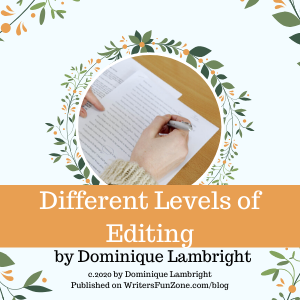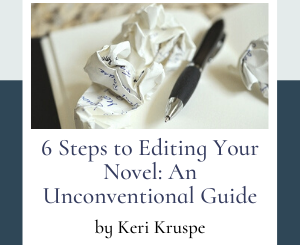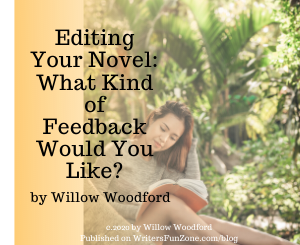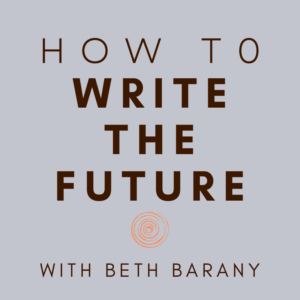Different Levels of Editing by Dominique Lambright
 Let’s welcome back monthly columnist Dominique Lambright as she shares with us “Different Levels of Editing.” Enjoy!
Let’s welcome back monthly columnist Dominique Lambright as she shares with us “Different Levels of Editing.” Enjoy!
***
Editing isn’t the big picture, but it doesn’t require a microscope. You can break it down into three types: heavy, medium, and light editing. At all levels, the editor corrects errors, queries the author about conflicting statements, requests advice when the means of resolving a problem is unclear, and prepares a style sheet.
- Light editing takes the least time and usually involves minor changes to the text. Light editing means the writing has little need for improvement. Wordiness is corrected here or there, punctuation or a subject-verb agreement mistake is corrected, or a few sentences are broken up or joined for clarity. Sometimes, light editing is what the writer has requested of a freelance editor regardless of actual existing issues. Here, only the most glaring or problematic issues are corrected.
- Correcting faulty spelling, grammar, and punctuation.
- Correcting incorrect usage (such as can for may).
- Checking consistency in characters
- Ensuring consistency in spelling, hyphenation, and capitalization.
A light copyedit does not involve interventions such as smoothing transitions. The editor checks content only to detect spots where there are holes in the story.
- Medium editing comes between light and heavy. Moderate (or average) editing takes more time and usually involves restructuring sentences and rephrasing.
- Performing all tasks for light copyediting.
- Flagging inaccurately used figures of speech.
- Ensuring that essential content is handled consistently and that criteria specified by the publisher are met.
- Ensuring that there are no significant questions or gaps in content that leave the reader confused “by accident,” not intended.
- Tracking the continuity of plot, setting, and character traits, and querying the discrepancies, in fiction manuscripts.
- Enforcing consistent style and tone in a multi-author fiction manuscript.
- Flagging ambiguous or incorrect statements that don’t add up in the story.
- Heavy editing takes the most time and usually involves significant restructuring and rephrasing at the sentence, paragraph, section, and manuscript levels. Heavy editing is the kind that blurs into substantive editing. It can mean almost a complete rewrite at the sentence level. But it could also mean working with a non-native, non-fluent English writer. The content might be fantastic from a developmental perspective. Still, sentences are cumbersome, paragraphs need better organization, and word choices aren’t the best.
- Performing all tasks for medium copyediting.
- Eliminating wordiness, triteness, and inappropriate jargon.
- Smoothing transitions and moving sentences to improve readability.
- Suggesting new ways to improve the content of the story to help with the flow.
- Suggesting and sometimes implementing additions and deletions, noting them at the sentence and paragraph level.
Science fiction, for example, most of the time, the goal is to create a whole new world that the reader can get lost in. World creation involves vivid details, a good pace of the story to make sure your reader is absorbing everything, and then making sure your terms and fictional characters are on point. This usually needs a heavy edit right from the start because of the depth of science fiction novels.
The key differences between heavy and medium edits are the levels of judgment and rewriting involved. In a heavy edit, the editor improves the flow of text rather than merely ensuring correct usage and grammar. They may suggest recasts rather than simply flagging problems. And they may enforce a uniform level, tone, and focus as specified by the publisher or developmental editor. This will also apply to how you see your story playing out and what you want your audience to receive from the story.
***
ABOUT THE AUTHOR
 Dominique Lambright is the owner of DML Editing & Writing, a one-stop-shop for your book editing, book formatting, and ghostwriting needs. She coaches writers to help them edit and write better, and has written 4 books on Amazon, amazon.com/author/dominiquelambright.
Dominique Lambright is the owner of DML Editing & Writing, a one-stop-shop for your book editing, book formatting, and ghostwriting needs. She coaches writers to help them edit and write better, and has written 4 books on Amazon, amazon.com/author/dominiquelambright.
She has two beautiful daughters who keep her focused and helps her strive to keep working at being a better person. She does everything for them and our future. She’s been writing for as long as she can remember. She’s loved words since she first learned how to write in Kindergarten.
Writing has been a consistent hobby turned career choice. And because she’s the type of person who keeps buying books even though she has tons to still read on her bookshelf, her work never feels like work. She loves what she does and knows she’ll never get tired of it.






